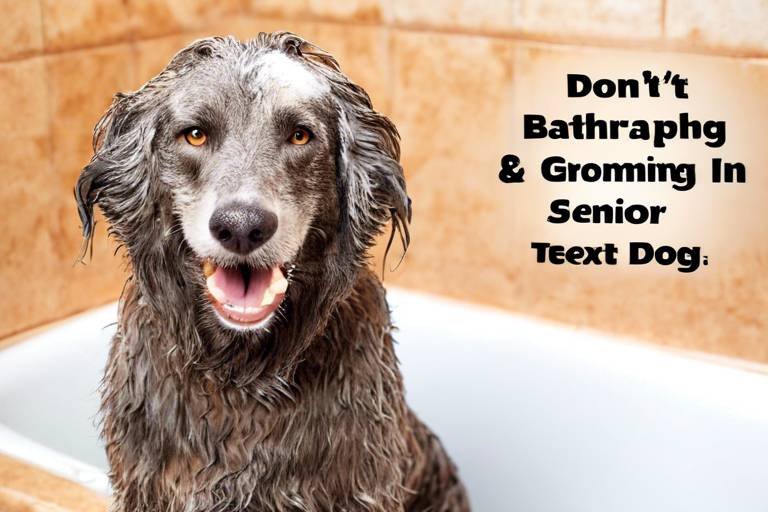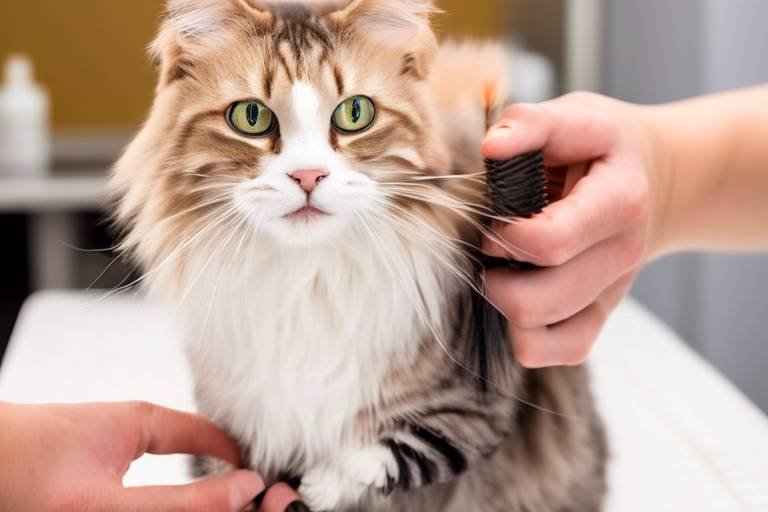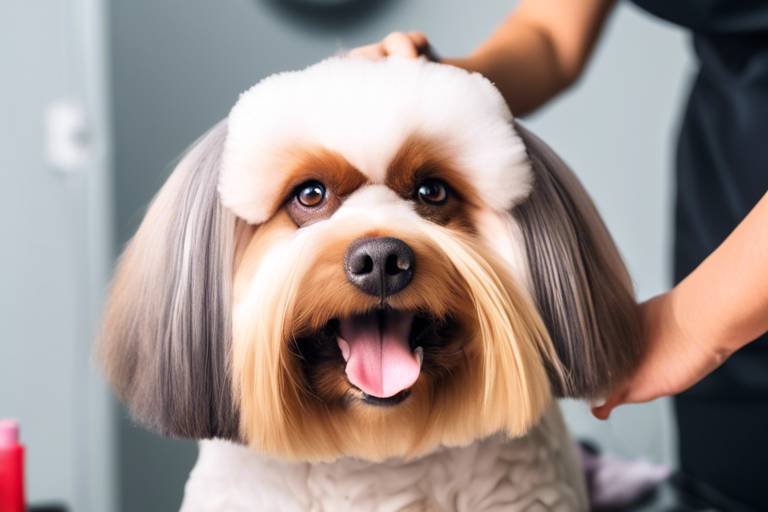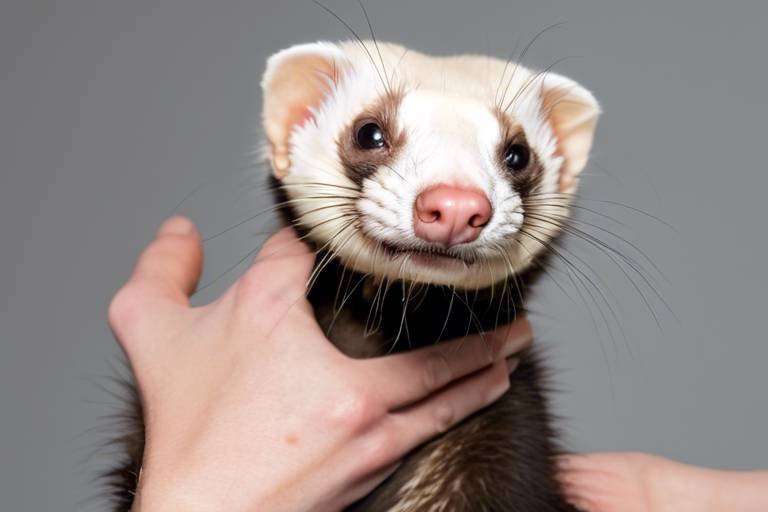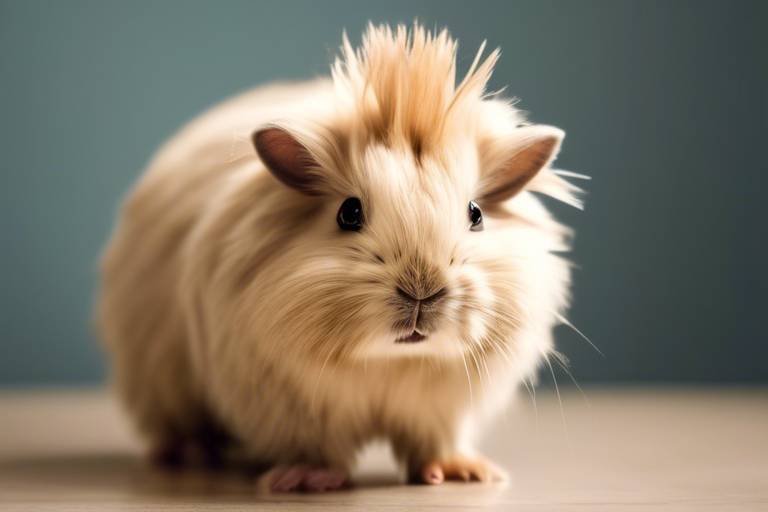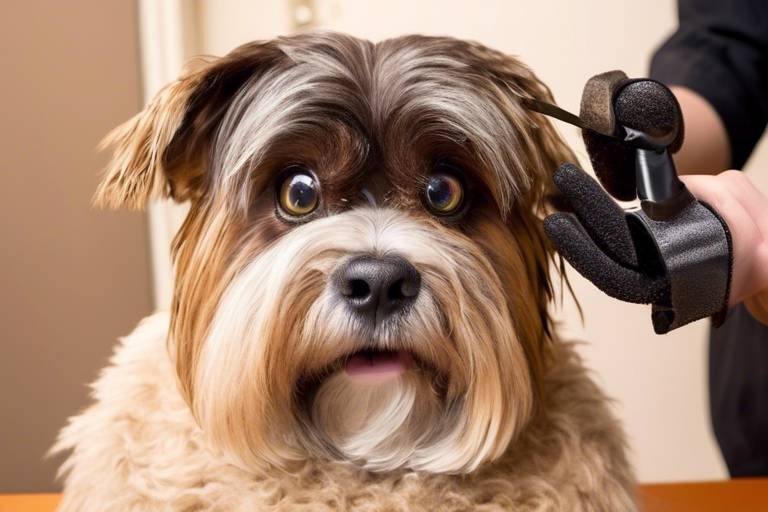The Importance of Grooming for Preventative Care
Grooming is often seen as a mere aesthetic practice, but it goes much deeper than that. It's a crucial part of both preventative care and overall well-being for pets and humans alike. Just as we brush our teeth and wash our hair to maintain hygiene and health, regular grooming for our furry friends is essential to keep them healthy and happy. Imagine grooming as a preventative shield—it not only enhances appearance but also plays a pivotal role in identifying potential health issues before they escalate into serious problems.
For pets, grooming is an opportunity to check for signs of skin issues, parasites, or even weight fluctuations. In humans, grooming rituals can boost confidence and self-esteem, making us feel good inside and out. The act of grooming can be likened to a health check-up; just as we visit our doctor for regular check-ups, our pets benefit immensely from routine grooming sessions. This article will delve into the multifaceted benefits of grooming, exploring how it contributes to both physical appearance and preventive health measures.
In the following sections, we will discuss the various benefits of regular grooming, how it aids in health monitoring, the emotional bonds it fosters, and the tools and techniques that can make the process smoother for everyone involved. Whether you're a pet owner or someone looking to enhance their grooming routine, understanding the importance of grooming will empower you to make informed choices that benefit your health and that of your furry companions.
Regular grooming is more than just a beauty regimen; it serves numerous health benefits. For pets, it promotes skin health, reduces shedding, and prevents matting, which can lead to discomfort and skin infections. In humans, grooming rituals can significantly boost confidence and self-esteem, making us feel more attractive and presentable in our daily lives. When we look good, we feel good, and that positive energy can ripple through all aspects of our lives.
Consider the following benefits of regular grooming:
- Skin Health: Regular brushing helps remove dirt, dead hair, and debris, promoting healthier skin for pets and ensuring our own skin remains clean and well-maintained.
- Reduced Shedding: Grooming minimizes the amount of hair that ends up on your furniture and clothes, making for a cleaner home environment.
- Preventing Matting: For pets with longer fur, regular grooming prevents painful tangles and mats that can lead to skin irritation.
One of the most significant advantages of grooming is the opportunity it provides for health monitoring. During grooming sessions, both pets and humans can spot potential health issues that might otherwise go unnoticed. For instance, a pet owner may discover a new lump or bump while brushing their dog, prompting a timely visit to the veterinarian. Similarly, humans can identify changes in their skin or hair that may warrant a trip to the dermatologist.
Regular grooming sessions are a great way to identify skin conditions early on. By keeping an eye on your pet’s skin, you can catch issues like rashes, redness, or unusual bumps before they develop into serious concerns. In humans, routine grooming allows for the observation of skin changes, which can be crucial for early detection of conditions like skin cancer.
Recognizing signs of skin irritation during grooming can lead to quicker veterinary consultations, ensuring that pets receive the care they need before conditions worsen. Look for:
- Redness or swelling
- Excessive scratching or licking
- Foul odor
Grooming is also essential for the early detection of parasites like fleas and ticks. These pests can cause significant health problems if not addressed promptly, leading to discomfort and even serious diseases in pets. For humans, regular grooming can help identify any signs of infestation, allowing for immediate action.
Another critical aspect of grooming is the ability to assess body condition and weight. By regularly grooming your pet, you can keep an eye on any changes in their body shape or weight, helping to prevent obesity-related issues. In humans, maintaining a grooming routine can also encourage healthy habits, as it often goes hand in hand with overall wellness.
Grooming is not just about health; it's also a fantastic way to strengthen the bond between pets and their owners. The time spent grooming can foster trust and comfort, which is essential for emotional well-being in both parties. Think of grooming as a shared experience that deepens your connection with your furry friend.
Establishing a positive grooming routine can help pets feel more comfortable and relaxed. This not only reduces stress during grooming sessions but also makes visits to the veterinarian less daunting. A calm grooming environment encourages cooperation, making the entire process smoother for both pet and owner.
Engaging in grooming activities serves as quality time spent together, enhancing the emotional connection between pets and their owners. This shared experience promotes overall happiness and well-being, creating cherished moments that both you and your pet will look forward to.
Using the right grooming tools and techniques is crucial for effective grooming. The right tools ensure comfort and safety for both pets and humans during the process. Selecting appropriate grooming tools tailored to specific needs can enhance the grooming experience, making it more enjoyable and effective.
When it comes to grooming, having the right tools can make all the difference. From brushes and combs to clippers and nail trimmers, each tool serves a specific purpose. Investing in quality grooming tools can provide a more pleasant experience for both you and your pet.
Implementing gentle grooming techniques can help minimize stress for pets. Creating a calming environment encourages cooperation and reduces anxiety during grooming sessions. Techniques such as using slow, gentle strokes and offering treats can make the process enjoyable.
While regular grooming at home is essential, utilizing professional grooming services can provide expert care and specialized treatments. Professional groomers are trained to handle various grooming needs, ensuring that pets receive the best grooming and health monitoring available.
Knowing when to seek professional grooming services can make a significant difference in maintaining a pet's health and appearance. This is especially true for breeds with specific grooming needs, such as those requiring regular haircuts or specialized skin care.
Professional groomers offer expertise and experience, providing thorough grooming services that may be challenging for pet owners to achieve at home. They can also spot potential health issues that may go unnoticed during at-home grooming sessions.
Q: How often should I groom my pet?
A: The frequency of grooming depends on the breed and coat type. Long-haired breeds may require grooming several times a week, while short-haired breeds may need grooming less frequently.
Q: Can grooming help with my pet’s anxiety?
A: Yes! Regular grooming can create a calming routine for pets, helping to reduce anxiety during grooming and veterinary visits.
Q: What should I do if I find a lump during grooming?
A: If you discover a lump or any unusual changes on your pet, it’s essential to consult your veterinarian for further evaluation.
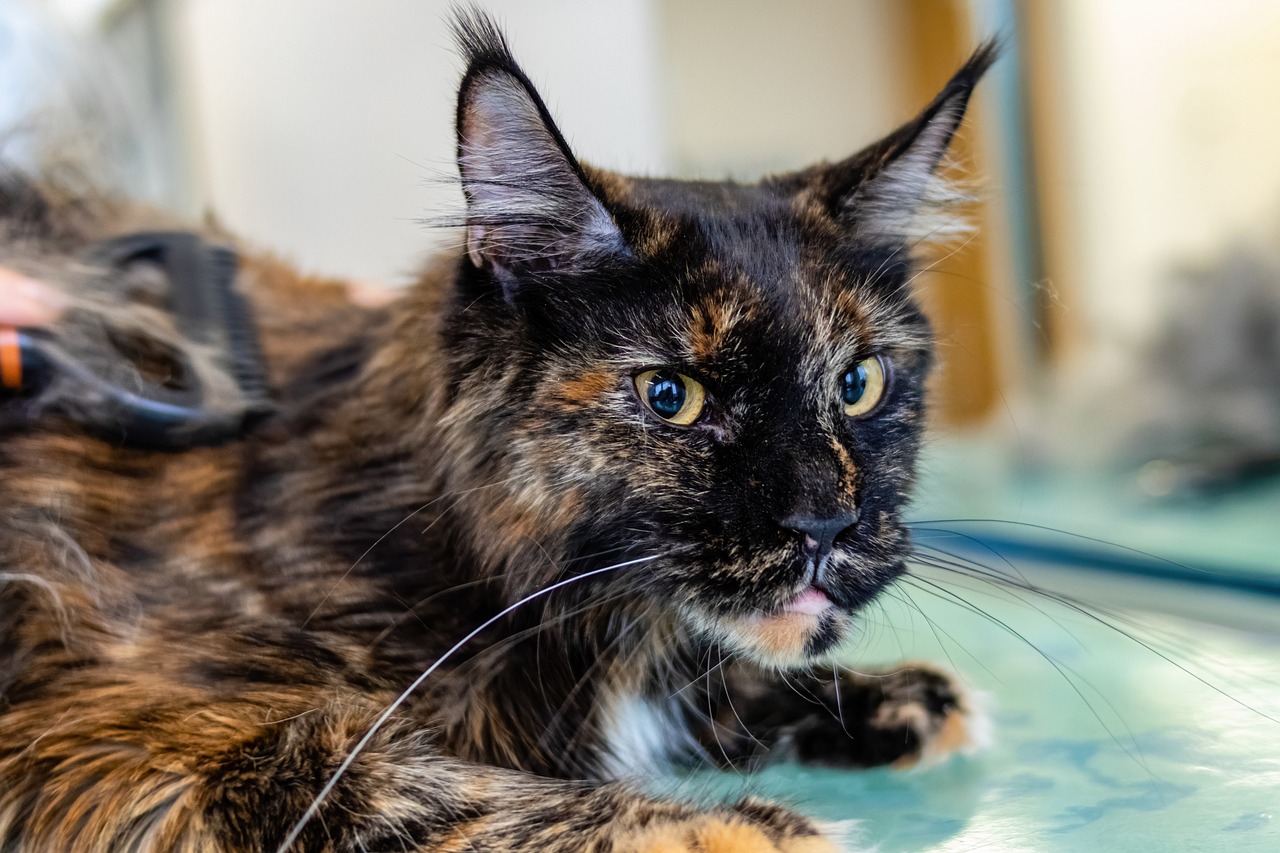
Benefits of Regular Grooming
Regular grooming is not just about keeping your pet looking fabulous; it plays a crucial role in their overall health and well-being. Think of grooming as a preventative care routine that keeps both pets and humans in tip-top shape. For pets, grooming helps to maintain a clean and healthy coat, which can significantly enhance their physical appearance. But the benefits extend far beyond aesthetics. With regular grooming, you can promote skin health, reduce shedding, and prevent the dreaded matting that can lead to discomfort and skin issues.
For humans, grooming can be a game-changer. Imagine stepping out of your house after a fresh haircut or a good skincare routine; don’t you feel like you can conquer the world? Regular grooming can boost your confidence and self-esteem, making you feel more presentable and ready to tackle whatever life throws your way. It’s amazing how something as simple as grooming can have such a profound impact on your mood and self-image.
Let’s not forget about the practical benefits. Regular grooming helps to reduce shedding in pets, which means less fur on your furniture and clothes. It’s a win-win situation! Additionally, grooming can aid in preventing skin issues by removing dirt, debris, and dead hair that can lead to irritations. For instance, a well-groomed coat allows for better air circulation, keeping the skin healthy and reducing the risk of infections.
Moreover, grooming can be a fun bonding experience between pets and their owners. Imagine the joy of brushing your dog while they wag their tail, or giving your cat a gentle rubdown as they purr contentedly. This shared time not only strengthens your relationship but also gives you a chance to check for any unusual signs or changes in your pet's body that might indicate health issues.
In summary, the benefits of regular grooming are multifaceted. It enhances appearance, promotes health, reduces shedding, and strengthens the bond between pets and their owners. So, whether you’re a pet parent or someone who enjoys personal grooming, make it a priority to include grooming in your routine. Your body, mind, and furry friends will thank you!

Grooming and Health Monitoring
When it comes to grooming, many people think of it merely as a way to keep their pets looking good. However, grooming is much more than just aesthetics. It serves as an essential tool for health monitoring that can lead to early detection of various health issues. Just like a routine check-up at the doctor’s office for humans, regular grooming sessions provide an opportunity to observe any changes in your pet’s body that could indicate underlying health problems.
During grooming, you can closely examine your pet's skin, coat, and overall body condition. This is particularly important because pets can’t communicate their discomfort or health issues verbally. For instance, while brushing your dog or cat, you might notice unusual lumps, bumps, or skin irritations that could warrant further investigation. This proactive approach can lead to timely treatment and ultimately a healthier, happier pet.
Moreover, grooming is an excellent opportunity to check for parasites, such as fleas and ticks. These pesky invaders can wreak havoc on your pet’s health if left unchecked. By regularly grooming your pet, you can spot these parasites early, which allows for immediate action. This is especially crucial in regions where parasite-related diseases are prevalent.
Another aspect to consider is weight management. Grooming provides a chance to assess your pet's body condition and weight. By keeping an eye on their physique during grooming sessions, you can help prevent obesity-related issues. Just as we monitor our own weight and health, it’s essential to do the same for our furry friends. A simple visual check during grooming can help you stay informed about your pet’s health status.
In summary, grooming is not just a beauty routine; it’s an integral part of health monitoring for both pets and humans. By incorporating regular grooming into your pet care routine, you can catch potential health problems early, ensuring that your beloved companion stays healthy and happy. So, the next time you pick up that brush or comb, remember that you’re not just making your pet look good—you’re also taking an important step in safeguarding their health.
- How often should I groom my pet? - The frequency of grooming depends on the breed and coat type. Long-haired breeds may require grooming several times a week, while short-haired breeds might only need grooming once a month.
- What signs should I look for during grooming? - Look for skin irritations, lumps, bumps, or any unusual behavior from your pet that could indicate discomfort.
- Can grooming help with shedding? - Yes! Regular grooming helps to remove loose fur and reduces shedding, keeping your home cleaner and your pet more comfortable.
Identifying Skin Conditions
When it comes to the health of our beloved pets, one of the most crucial aspects to monitor is their skin condition. Regular grooming sessions serve as an invaluable opportunity to spot any abnormalities early on. Just like a detective seeking clues, pet owners can use grooming as a time to inspect their furry friends for any signs of skin issues that might otherwise go unnoticed. Think of grooming as your pet's personal health check-up—it's not just about looking good; it's about feeling good too!
During grooming, pay close attention to the following signs that may indicate skin conditions:
- Redness or Inflammation: If you notice any areas of redness, it could be a sign of irritation or an allergic reaction.
- Dry or Flaky Skin: Dull, dry patches may suggest that your pet's skin is dehydrated or lacking essential nutrients.
- Unusual Odors: A strong, unpleasant smell can indicate an infection or fungal issue that requires immediate attention.
- Excessive Scratching: If your pet is scratching more than usual, it might be a sign of parasites or allergies.
- Lumps or Bumps: Any new growths on the skin should be examined closely, as they could be benign or something more serious.
Identifying these conditions early can make a world of difference. For instance, if you notice your dog scratching excessively, it might be time to check for fleas or ticks. Conversely, if you find a lump, it’s best to consult with your veterinarian as soon as possible. Early detection can lead to timely treatment, preventing more serious health issues from developing down the line.
Moreover, grooming isn’t just about the physical aspects; it also fosters a deeper connection between you and your pet. When you take the time to examine their skin and coat closely, you’re not only keeping them healthy but also nurturing your bond. This shared experience can enhance trust and comfort, making your pet feel secure in your care.
In conclusion, regular grooming is a powerful tool in identifying skin conditions before they escalate into serious health problems. By being vigilant and proactive, you can ensure your pet remains not only looking fabulous but also feeling their best. Remember, a happy pet is a healthy pet!
- How often should I groom my pet? It depends on the breed and coat type. Generally, long-haired pets require grooming several times a week, while short-haired pets may need it less often.
- What tools do I need for grooming? Basic grooming tools include brushes, combs, nail clippers, and shampoos. Choose tools that suit your pet's specific needs.
- Can I groom my pet at home? Yes! With the right tools and techniques, many pet owners can successfully groom their pets at home. However, some breeds may require professional grooming.
- What should I do if I find a skin condition? Consult your veterinarian as soon as possible for an accurate diagnosis and appropriate treatment.
Signs of Skin Irritation
When it comes to the health of our beloved pets, being proactive is key. One of the most important aspects of regular grooming is the ability to spot skin irritation early on. Just like humans, pets can suffer from various skin issues, and being aware of the signs can make all the difference. So, what should you be looking out for during those grooming sessions? Here are some common indicators of skin irritation:
- Redness or Inflammation: If you notice any areas on your pet's skin that appear red or inflamed, it could be a sign of irritation or an allergic reaction. This is often one of the first signs that something isn’t right.
- Excessive Scratching or Biting: Is your pet constantly scratching or biting at a particular spot? This behavior is a clear indication that something is bothering them. It’s their way of trying to relieve discomfort.
- Flaky or Scaly Skin: Dandruff-like flakes or scales can indicate dry skin or a more serious condition. Pay attention to any changes in texture, as this could signal a need for further investigation.
- Odor: A foul smell can be a telltale sign of skin infections or other underlying issues. If your pet starts to smell unusual, it’s time to take a closer look.
- Hot Spots: These are localized areas of inflammation that can develop quickly, often due to scratching or biting. They are usually red, moist, and can become quite painful if left untreated.
Recognizing these signs during grooming can lead to quicker veterinary consultations, ensuring that your furry friend receives the care they need before conditions worsen. Remember, just like with humans, early detection is crucial in preventing more serious health issues from developing. If you notice any of these symptoms, don’t hesitate to reach out to your vet for advice. Your pet’s comfort and health should always come first!
1. How often should I groom my pet?
The frequency of grooming depends on your pet's breed and coat type. Long-haired breeds may require grooming several times a week, while short-haired breeds might only need it once a month.
2. What tools should I use for grooming?
The right tools vary by pet, but common grooming tools include brushes, combs, clippers, and nail trimmers. Always choose tools that are appropriate for your pet's coat type.
3. Can I groom my pet at home?
Absolutely! Many pet owners groom their pets at home. However, for specialized needs or if you're unsure, seeking professional help is always a good idea.
4. What should I do if I find a skin issue?
If you notice any signs of skin irritation, consult your veterinarian as soon as possible. Early intervention can prevent more serious health issues.
5. How can I make grooming a positive experience for my pet?
Start slowly, use treats and praise, and create a calm environment. Making grooming a routine can help your pet feel more comfortable over time.
Parasite Detection
Grooming plays a pivotal role in the early detection of parasites, which can be a significant health concern for both pets and humans. During grooming sessions, pet owners have the unique opportunity to closely examine their furry friends for signs of unwanted guests such as fleas, ticks, and mites. These parasites not only cause discomfort but can also lead to serious health issues if left untreated. For instance, fleas can transmit diseases and cause skin infections, while ticks can carry Lyme disease, which poses risks to both pets and their human companions.
When grooming your pet, it's essential to be vigilant. Look for the following signs that may indicate the presence of parasites:
- Excessive scratching or biting: If your pet is scratching more than usual, it could be a sign of fleas or other skin irritants.
- Red or inflamed skin: Areas of redness or irritation can indicate an allergic reaction to flea bites or other parasites.
- Hair loss: Patches of hair loss might suggest a more serious issue, including parasitic infections.
- Visible parasites: Sometimes, you may actually see fleas or ticks on your pet's coat, especially in areas like the ears, neck, and underbelly.
In addition to visual checks, grooming allows pet owners to feel for unusual lumps or bumps on their pet’s skin, which could indicate the presence of a tick or other parasites. Regular grooming sessions can significantly reduce the likelihood of a full-blown infestation, as early detection leads to prompt treatment. If you notice any signs of parasites during grooming, it's crucial to consult with a veterinarian as soon as possible. They can provide effective treatments and advice on how to prevent future infestations.
Moreover, grooming can also serve as a preventive measure. By establishing a routine that includes thorough brushing and bathing, pet owners can create an environment that is less hospitable to parasites. For instance, regular baths can help wash away any fleas or ticks that may have recently jumped onto your pet. Additionally, using flea and tick prevention products in conjunction with grooming can provide a comprehensive approach to keeping your pets healthy and parasite-free.
Q: How often should I groom my pet to detect parasites?
A: It's recommended to groom your pet at least once a week. This not only helps with parasite detection but also keeps their coat healthy and clean.
Q: What should I do if I find fleas or ticks on my pet?
A: If you find fleas or ticks, consult your veterinarian for appropriate treatment options. They can recommend topical treatments, oral medications, or other solutions to eliminate the parasites.
Q: Can grooming help prevent future infestations?
A: Yes! Regular grooming, combined with preventive treatments, can significantly reduce the chances of future infestations by keeping your pet’s coat clean and healthy.
Monitoring Weight and Body Condition
Keeping an eye on your pet's weight and body condition is crucial for their overall health and longevity. Just as we humans need to watch our waistlines and maintain a healthy lifestyle, our furry friends require the same attention. Regular grooming sessions provide an excellent opportunity to assess your pet's body condition and weight. During these grooming sessions, you can feel for any unusual lumps or bumps, check their waistline, and observe their overall physique. It's like a mini health check-up right in your living room!
But how do you know if your pet is at a healthy weight? One effective method is to use the Body Condition Score (BCS), which is a scale that helps you evaluate whether your pet is underweight, ideal weight, or overweight. Typically, this scale ranges from 1 to 9, with 1 being extremely thin and 9 being extremely overweight. A score of 4 or 5 is generally considered ideal for most pets. Here's a simple breakdown:
| Body Condition Score | Description |
|---|---|
| 1 | Extremely Thin - Ribs, spine, and bones are easily visible. |
| 2 | Thin - Ribs are visible with minimal fat covering. |
| 3 | Underweight - Ribs can be felt easily; waist is noticeable. |
| 4 | Ideal - Ribs can be felt with a slight fat covering; waist is visible. |
| 5 | Ideal - Ribs are palpable without excess fat; waist is well-defined. |
| 6 | Overweight - Ribs can be felt with some difficulty; waist is less defined. |
| 7 | Obese - Ribs are difficult to feel; noticeable fat deposits. |
| 8 | Very Obese - Ribs are not palpable; excessive fat deposits. |
| 9 | Extremely Obese - Massive fat deposits; serious health risks. |
By regularly grooming your pet and assessing their body condition, you can catch potential weight issues before they become serious health problems. For example, if you notice that your pet is gaining weight, it might be time to adjust their diet or increase their activity level. Conversely, if your pet is losing weight, it could indicate underlying health issues that require veterinary attention. Think of it as being your pet's personal trainer; you’re not just helping them look good, but you’re also ensuring they feel good!
Remember, monitoring weight and body condition isn't just about aesthetics. It's about ensuring your pet leads a happy, healthy, and active life. So, the next time you groom your furry friend, take a moment to check in on their body condition. It’s a simple yet effective way to show you care!
- How often should I groom my pet? - It depends on the breed and coat type, but generally, regular grooming every few weeks is recommended.
- What if I notice my pet is overweight? - Consult your veterinarian for advice on diet and exercise tailored to your pet's needs.
- Can grooming help with shedding? - Yes! Regular grooming can significantly reduce shedding by removing loose fur and preventing matting.
- Is it necessary to use professional grooming services? - While many pets can be groomed at home, professional groomers can provide specialized care, especially for breeds with unique grooming needs.
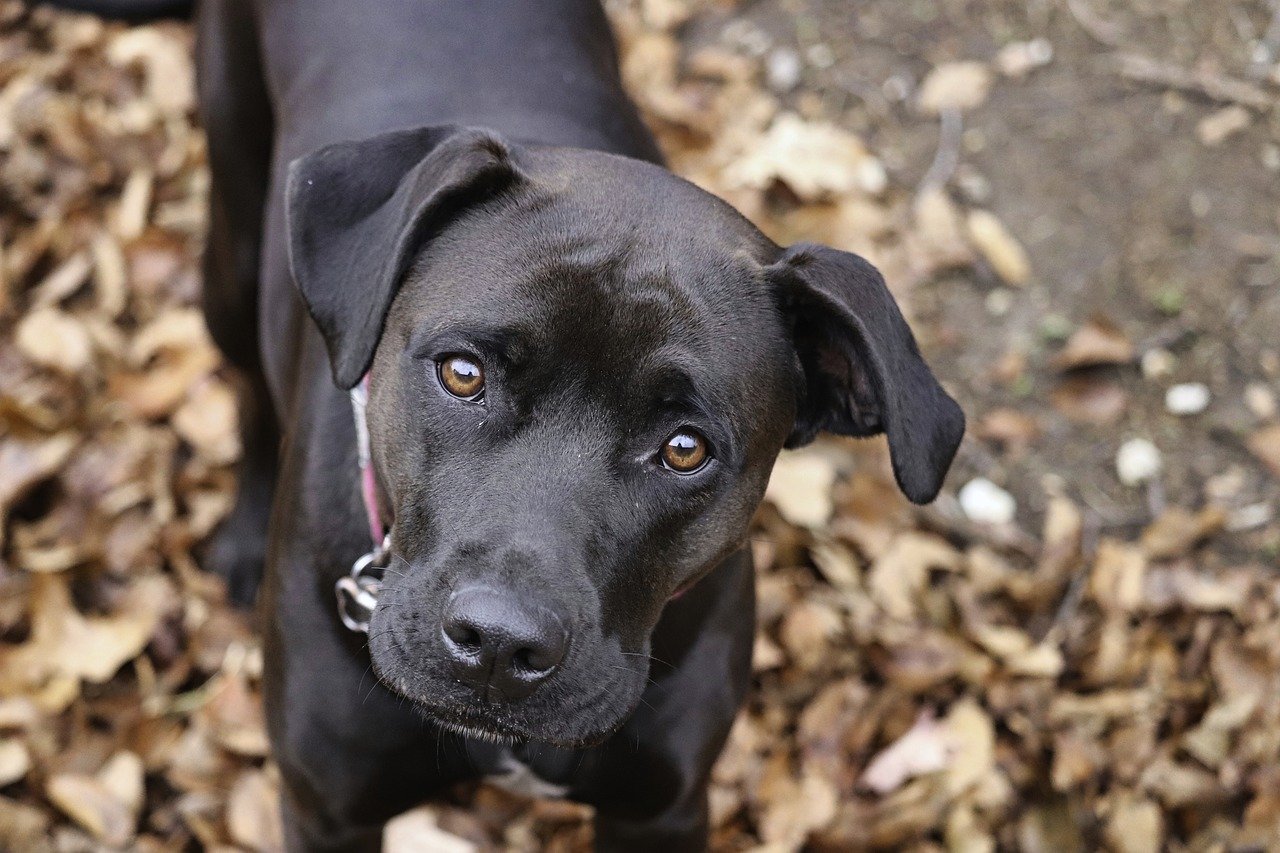
Building a Bond Through Grooming
Grooming is so much more than just a routine task; it's a wonderful opportunity to strengthen the bond between pets and their owners. When you engage in grooming, you’re not only taking care of your pet’s physical appearance but also nurturing the emotional connection that is vital for both of you. Think of it as a form of quality time—a moment to pause, connect, and share affection. Just like humans enjoy a spa day, pets can find comfort in the gentle strokes of a brush or the soothing sounds of a grooming session.
Establishing a positive grooming routine can significantly change how your pet perceives these sessions. Imagine the difference it makes when you approach grooming with a calm demeanor and a soft touch. This can help your pet feel more comfortable and relaxed, reducing any anxiety they might have about the process. Over time, your pet will start to associate grooming with love and care, rather than just a chore. You can enhance this experience by incorporating treats or praise, creating a rewarding atmosphere that encourages cooperation.
Moreover, grooming is a fantastic way to observe your pet's behavior and mood. During these intimate moments, you can pick up on subtle changes that may indicate stress or discomfort, allowing you to address any underlying issues. This attentiveness not only helps in keeping your pet healthy but also deepens your understanding of their needs, fostering a sense of trust. Just like how we feel more connected to friends after sharing experiences, your bond with your pet grows stronger with each grooming session.
Think of grooming as a shared ritual. It’s a time to communicate without words, where each brush stroke and gentle tug can say, “I care about you.” This connection is crucial for your pet’s emotional well-being. When pets feel secure in their relationship with you, it can lead to improved behavior, reduced anxiety during vet visits, and an overall happier pet. The bond you build through grooming can transform your relationship into one filled with trust and joy.
In conclusion, grooming is not just about aesthetics; it’s about creating lasting memories and connections. It’s an opportunity to show your pet that they are loved and valued, which can have a profound impact on their overall happiness. So, the next time you pick up that brush or shampoo, remember that you’re not just grooming your pet; you’re building a bond that will last a lifetime.
- How often should I groom my pet? It depends on the breed and coat type, but generally, regular grooming every few weeks is beneficial.
- Can grooming help with my pet's anxiety? Yes, establishing a calm grooming routine can reduce anxiety and build trust between you and your pet.
- What are the best tools for grooming? The right tools vary by pet, but common items include brushes, combs, and nail clippers tailored to your pet's coat type.
- Should I consider professional grooming? If your pet has specific grooming needs or you’re unsure about how to groom them properly, professional groomers can provide expert care.
Creating a Positive Experience
Creating a positive grooming experience is essential for both pets and their owners. Imagine this: you’re getting ready for a big day out, but the thought of a tedious grooming session makes you feel anxious. Now, think about your furry friend. They might feel the same way if grooming isn’t approached correctly. The key here is to transform grooming from a chore into a delightful bonding activity. By establishing a routine that feels comfortable and enjoyable, you can help your pet look forward to grooming sessions rather than dread them.
One effective way to create a positive experience is to incorporate playfulness into the grooming routine. For instance, before you start brushing, take a few moments to play with your pet. This can be as simple as tossing a favorite toy or engaging in a quick game of fetch. This initial fun can help alleviate any anxiety and set a relaxed tone for the grooming session. Additionally, using gentle techniques while grooming can make a world of difference. Always start with light strokes and gradually increase pressure as your pet becomes more comfortable.
Another important aspect is to choose the right environment. A calm, quiet space can significantly affect your pet's mood. Consider creating a designated grooming area that is free from distractions and loud noises. Soft lighting and soothing background music can also help create a serene atmosphere. Remember, your energy matters too! If you approach grooming with a calm and positive demeanor, your pet is likely to mirror that attitude.
Incorporating treats and rewards can also enhance the experience. After each grooming session, reward your pet with a small treat or their favorite toy. This not only reinforces good behavior but also creates a positive association with grooming. Over time, your pet will learn to look forward to these sessions, eagerly anticipating the pampering and rewards that come with them.
Lastly, patience is key. Just like humans, pets have their own comfort levels and may need time to adjust to grooming. If your pet shows signs of stress or discomfort, take a break and try again later. By being attentive to their needs and maintaining a flexible approach, you can ensure that grooming becomes a cherished time of connection rather than a source of stress.
- How often should I groom my pet? It depends on the breed and coat type. Generally, long-haired breeds require more frequent grooming than short-haired ones.
- What tools do I need for grooming? Basic tools include a brush, comb, scissors, and nail clippers. Specific breeds may require specialized tools.
- Can I groom my pet at home? Yes! Many pet owners successfully groom their pets at home with the right tools and techniques.
- When should I seek professional grooming services? If your pet has specific grooming needs or if you’re unsure about how to handle certain grooming tasks, it's best to consult a professional.
Grooming as Quality Time
When you think of grooming, what comes to mind? Is it just a chore or a necessity? Well, let me tell you, grooming can be so much more than that! It’s an opportunity to transform a mundane task into a cherished moment of bonding with your furry friend. Imagine this: you’re gently brushing your pet’s coat, their eyes sparkling with joy, and you can feel the warmth of their trust radiating back at you. This is quality time, and it’s invaluable for both of you!
Engaging in grooming activities isn’t just about keeping your pet looking fabulous; it’s about creating a shared experience that strengthens your connection. Think of it as a mini spa day for your pet, where they get pampered and you get to show them love and care. The rhythmic motion of brushing, the gentle tug of a comb, and even the playful banter you share can turn an ordinary grooming session into a delightful ritual. It’s a win-win!
Moreover, grooming sessions can serve as a fantastic way to observe your pet’s behavior and mood. Are they enjoying the brush strokes? Are they more relaxed than usual? These moments allow you to tune into their feelings and build a deeper understanding of their needs. It’s like having a heart-to-heart conversation, but without words. You can even incorporate treats and praises during grooming to make the experience even more enjoyable, reinforcing positive behavior and encouraging them to look forward to your next session together.
Incorporating grooming into your routine can also help make it a stress-free experience. The more you groom your pet, the more accustomed they become to the process. This familiarity breeds comfort, which in turn makes those trips to the vet less daunting for them. So, not only are you creating quality time, but you’re also preparing them for future experiences that may otherwise be anxiety-inducing.
So, grab that brush and start making grooming a special time for you and your pet! Whether it’s a daily ritual or a weekly affair, these moments can significantly enhance your relationship, leading to a happier, healthier, and more connected life together. Remember, it’s not just about keeping up appearances; it’s about nurturing a bond that lasts a lifetime.
- How often should I groom my pet? The frequency of grooming depends on the breed and coat type. Long-haired breeds may require daily grooming, while short-haired ones could be fine with weekly sessions.
- Can grooming help with my pet's anxiety? Yes! Regular grooming can create a calming routine, helping to reduce anxiety during other stressful situations.
- What if my pet doesn't like being groomed? Start slowly and make it a positive experience with treats and praise. If they continue to resist, consider consulting a professional groomer for tips.
- Are there specific tools I should use for grooming? Yes, the right tools depend on your pet’s coat type. Brushes, combs, and clippers vary, so do some research to find what works best for your pet.
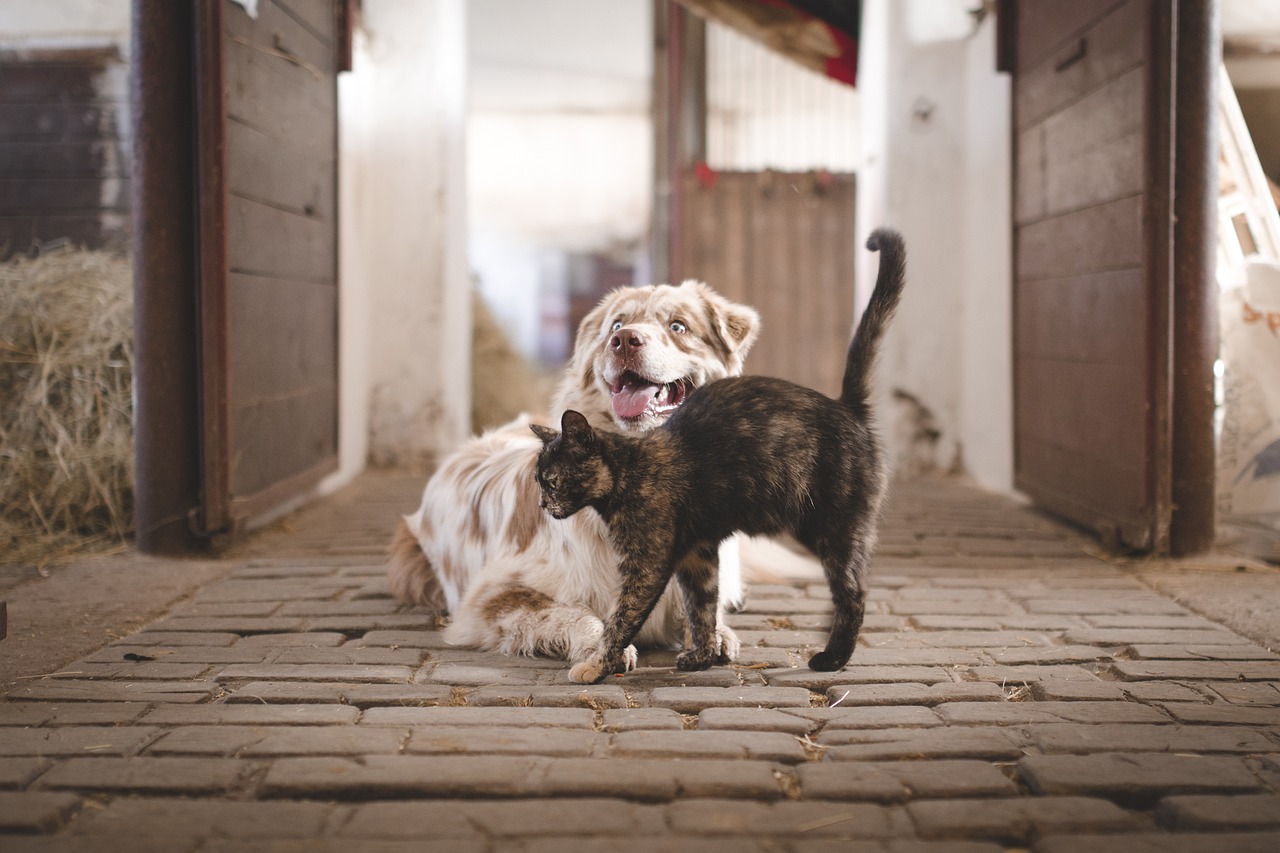
Grooming Tools and Techniques
When it comes to grooming, having the right tools and employing effective techniques can make all the difference in creating a positive experience for both pets and their owners. Just like a chef needs the right knives to prepare a delicious meal, a pet owner requires specific grooming tools to keep their furry friends looking and feeling their best. The selection of grooming tools is vast, but understanding what to use and when is key to achieving great results.
First and foremost, it's essential to choose the right tools based on your pet's specific needs. For instance, long-haired breeds may require a wide-toothed comb and a pin brush to prevent tangles and mats, while short-haired breeds might benefit more from a rubber grooming mitt that helps remove loose fur and dirt. Each tool serves a purpose, and using the appropriate one can enhance the grooming experience significantly.
Here’s a quick overview of some essential grooming tools:
| Tool | Purpose |
|---|---|
| Brush | Removes loose hair and prevents matting |
| Comb | Detangles fur and smooths the coat |
| Clippers | Trims fur for a neat appearance |
| Nail Clippers | Maintains nail health and prevents overgrowth |
| Ear Cleaner | Maintains ear hygiene and prevents infections |
Once you have the right tools, the next step is mastering the techniques. Grooming should always be a gentle and calming experience. Start by creating a comfortable environment for your pet. Make sure the grooming area is quiet and free from distractions. You might want to use treats or toys to help your pet associate grooming with positive experiences. This is especially important for pets that may feel anxious during grooming sessions.
When grooming, always begin with a gentle brush to remove any loose hair. For pets with longer fur, working in sections can make the process more manageable. Use a comb to tackle any knots, and be sure to be gentle—pulling too hard can cause discomfort. Remember, grooming is not just about aesthetics; it’s also an opportunity to check for any signs of skin issues or parasites.
In addition to basic grooming, it’s essential to incorporate regular checks of your pet’s body. During grooming sessions, take the time to feel for any lumps or bumps, which could indicate health issues that need addressing. This not only helps in maintaining a well-groomed appearance but also plays a crucial role in your pet's overall health.
Lastly, don't forget about the importance of regular grooming for yourself! Just like our pets, we also benefit from maintaining our hygiene and appearance. So, while you're grooming your furry friend, take a moment to pamper yourself too. After all, a little self-care goes a long way in boosting confidence and promoting well-being!
- How often should I groom my pet? It depends on the breed and coat type. Long-haired breeds may require grooming several times a week, while short-haired breeds may only need grooming once a month.
- What tools do I need for grooming? Basic tools include a brush, comb, nail clippers, and ear cleaner. The specific tools may vary based on your pet's breed.
- Can I groom my pet at home? Yes! With the right tools and techniques, you can groom your pet at home. Just ensure you create a comfortable environment and be gentle.
- When should I seek professional grooming services? If your pet has specific grooming needs, such as a breed that requires specialized cuts, or if you notice any health issues during grooming, it’s best to consult a professional.
Choosing the Right Tools
When it comes to grooming, selecting the right tools is crucial for creating a positive experience for both you and your pet. The variety of grooming tools available can be overwhelming, but understanding your pet's specific needs can help simplify the process. For instance, different breeds have varying coat types, which require specific grooming implements. A long-haired breed may need a slicker brush to prevent matting, while a short-haired breed might benefit from a rubber curry brush to remove loose hair and stimulate the skin.
It's important to consider the comfort and safety of your pet during grooming sessions. Tools that are too harsh can cause discomfort, leading to a negative association with grooming. Look for brushes with rounded tips to protect the skin and avoid pulling on the fur. Additionally, grooming scissors should be blunt-tipped to prevent accidental injuries. Investing in high-quality tools not only makes the grooming process easier but also ensures that you are providing the best care for your furry friend.
Here are some essential grooming tools that you might consider:
- Brushes: Choose a brush that suits your pet's coat type.
- Combs: A fine-toothed comb can help with tangles and mats.
- Scissors: Blunt-tipped scissors are safer for trimming fur.
- Clippers: If your pet requires a trim, invest in a quality clipper.
- Shampoo: Use a pet-safe shampoo that suits your pet’s skin type.
In addition to these tools, consider the environment in which you groom your pet. A calm, quiet space can make a world of difference in how your pet reacts to grooming. Proper lighting is also essential to ensure you can see what you're doing and avoid any mishaps.
Ultimately, the right tools can transform grooming from a chore into a bonding experience. By carefully selecting the appropriate implements and creating a soothing environment, you can help your pet feel relaxed and comfortable, making the grooming process a positive one. Remember, grooming is not just about aesthetics; it's about maintaining health and happiness for your beloved companion.
Q: How often should I groom my pet?
A: The frequency of grooming depends on your pet's breed and coat type. Long-haired breeds may require grooming several times a week, while short-haired breeds might only need grooming every few weeks.
Q: Can I use human grooming tools on my pet?
A: It's best to use tools specifically designed for pets. Human grooming tools may not be safe or effective for animal fur and skin.
Q: What should I do if my pet hates grooming?
A: Start slowly and make the grooming experience as positive as possible. Use treats and praise to reward your pet and gradually increase the duration of grooming sessions.
Q: Are professional grooming services worth it?
A: Yes, professional groomers have the expertise and tools necessary to handle specific grooming needs, especially for breeds that require specialized care.
Techniques for Stress-Free Grooming
Grooming your pet can be a delightful experience, but it can also lead to stress if not approached correctly. To ensure that both you and your furry friend enjoy the grooming process, it's essential to adopt some stress-free techniques. First and foremost, creating a calm and comfortable environment is crucial. Find a quiet space where you can groom without interruptions. This can make a significant difference in how your pet reacts during grooming. Consider using a non-slip mat to provide stability, which can help your pet feel secure.
Another effective technique is to introduce grooming tools gradually. Instead of bringing out all the tools at once, start with one item, such as a brush. Allow your pet to sniff and explore the brush before you begin grooming. This helps them associate the tool with positive experiences rather than fear. Additionally, you can reward your pet with treats and praise during and after grooming sessions, reinforcing their good behavior and making the experience more enjoyable.
Timing is also an essential factor to consider. Choose a time when your pet is naturally calm, such as after a walk or play session. This way, they are less likely to be hyperactive or anxious. If your pet shows signs of distress, take a break. It's okay to stop and resume the grooming later, ensuring that your pet does not associate grooming with negative experiences. You might also want to consider playing soothing music in the background to create a relaxing atmosphere.
Incorporating gentle brushing techniques can further reduce stress. Use slow, gentle strokes and avoid pulling on tangles or mats. If your pet has particularly long or thick fur, consider using a detangling spray to ease the process. Regular grooming at home can help your pet become accustomed to the sensation, making future sessions smoother. If your pet is particularly anxious, you might even want to practice short grooming sessions that gradually increase in length over time.
Lastly, don't forget to communicate with your pet throughout the grooming process. Talk to them in a soothing voice, and let them know they're doing a great job. This not only calms them but also strengthens the bond between you. Remember, grooming should be a positive experience for both you and your pet. By implementing these techniques, you can transform grooming from a dreaded task into a cherished bonding time.
- How often should I groom my pet? The frequency of grooming depends on your pet's breed and coat type. Long-haired breeds may require grooming several times a week, while short-haired breeds might only need it once a month.
- What tools do I need for grooming my pet? Basic grooming tools include a brush, comb, nail clippers, and a grooming mitt. The specific tools may vary based on your pet's coat type.
- What if my pet doesn’t like grooming? If your pet shows signs of distress, take it slow. Gradually introduce grooming and use treats to create a positive association.
- Can I groom my pet at home? Yes, many pet owners successfully groom their pets at home. However, some pets may require professional grooming, especially those with specific grooming needs.

Professional Grooming Services
When it comes to keeping our furry friends looking their best, can be a game-changer. These services not only enhance your pet's appearance but also ensure that they receive the specialized care they need. Imagine walking into a grooming salon where experts are ready to pamper your pet with the latest techniques and tools. It's like taking your car to a mechanic who knows exactly how to tune it up for optimal performance! But when should you consider seeking out these services?
There are several scenarios where professional grooming becomes essential. For instance, certain breeds require specific grooming techniques that can be quite challenging for the average pet owner. Breeds with long or thick fur, such as Shih Tzus or Golden Retrievers, often need regular trims and maintenance to prevent matting and skin issues. Additionally, if you notice any signs of skin irritation or parasites during at-home grooming, it’s wise to consult a professional who can provide a thorough examination and treatment.
Moreover, professional groomers are trained to handle a variety of situations that may arise during grooming sessions. They have the experience to manage anxious pets, ensuring a calm and stress-free environment. This is particularly important for pets that may be nervous or aggressive during grooming. By utilizing calming techniques and gentle handling, professional groomers can make the experience pleasant for both the pet and the owner.
Here are some key benefits of using professional grooming services:
- Expertise: Professional groomers possess the knowledge and skills necessary to handle different breeds and their unique grooming needs.
- Specialized Equipment: They use high-quality tools and products that may not be available to the average pet owner, ensuring a thorough and effective grooming process.
- Health Monitoring: Groomers can spot potential health issues, such as skin problems or lumps, that you might miss at home.
- Time-Saving: Professional grooming can save you time, allowing you to focus on spending quality moments with your pet rather than struggling with grooming tasks.
So, how do you know when it’s time to seek professional help? If your pet’s coat is tangled, matted, or you feel overwhelmed by the grooming process, it’s probably a good idea to book an appointment. Additionally, if your pet has specific health concerns or requires specialized grooming for show purposes, don’t hesitate to reach out to a professional. They can provide tailored services that cater to your pet's individual needs.
In conclusion, while at-home grooming can be a bonding experience, there are times when professional services are invaluable. The expertise, specialized tools, and attention to health that professional groomers offer can significantly enhance your pet's well-being and appearance. Think of it as giving your pet the royal treatment they deserve!
Q: How often should I take my pet to a professional groomer?
A: It depends on the breed and coat type. Generally, long-haired breeds may need grooming every 4-6 weeks, while short-haired breeds can go longer.
Q: Can professional groomers help with behavioral issues during grooming?
A: Yes, experienced groomers are trained to handle behavioral issues and can help make the grooming experience more comfortable for anxious pets.
Q: What should I look for in a professional grooming service?
A: Look for groomers with good reviews, a clean facility, and staff who are knowledgeable about pet care and grooming techniques.
When to Seek Professional Help
Knowing when to seek professional grooming services can be a game changer for maintaining your pet's health and appearance. While regular grooming at home is essential, there are specific circumstances where the expertise of a professional groomer becomes invaluable. For instance, if your pet has a breed-specific coat that requires specialized techniques, such as poodles or terriers, it’s wise to consult a professional. These breeds often have unique grooming needs that can be challenging to manage without proper training and tools.
Another scenario to consider is if you notice any signs of distress or discomfort in your pet during grooming sessions. Pets can be sensitive, and if they exhibit behaviors like excessive barking, growling, or trying to escape, it might indicate that they require a gentler touch or specialized approach that a professional can provide. Additionally, if your pet has developed mats or tangles that are beyond your ability to manage, a professional groomer has the skills and equipment to safely remove these without causing pain or stress to your furry friend.
Moreover, if your pet has underlying health conditions, such as skin allergies or sensitivity, a professional groomer can offer tailored services that cater to these needs. They can also provide valuable advice on suitable grooming products that won't irritate your pet's skin. For instance, if your pet has been scratching excessively, a professional can help identify if it's due to a grooming issue or a deeper health concern.
Lastly, if you’re simply overwhelmed by the grooming process or don’t have the time to dedicate to it, seeking professional help can relieve that burden. Professional groomers not only save you time but also ensure that your pet looks and feels their best. They can also provide a thorough health check during grooming, catching potential issues early on. So, whether it’s for a special occasion or regular upkeep, don’t hesitate to reach out for professional assistance when needed. Your pet deserves the best care possible!
- How often should I take my pet to a professional groomer?
It depends on the breed and coat type. Long-haired breeds may need grooming every 4-6 weeks, while short-haired breeds might only need it every few months. - What should I look for in a professional groomer?
Look for certifications, experience, and reviews from other pet owners. A good groomer will also be patient and gentle with your pet. - Can I groom my pet at home?
Yes, regular grooming at home is beneficial. However, for specific needs or if your pet shows signs of distress, consider seeking professional help. - What if my pet has skin issues?
Always consult a veterinarian before grooming. A professional groomer can help, but underlying issues may need medical attention first.
Benefits of Professional Groomers
When it comes to grooming our beloved pets, many owners often wonder if they should take the plunge and seek out the expertise of professional groomers. The answer is a resounding yes! Professional groomers bring a wealth of knowledge and experience to the table, ensuring that your furry friends receive the best possible care. Not only do they possess specialized skills, but they are also equipped with a variety of tools that can make the grooming process more effective and enjoyable for both pets and their owners.
One of the most significant advantages of hiring a professional groomer is their ability to handle various breeds and temperaments. Different dog and cat breeds have unique grooming requirements, and a professional groomer is trained to understand these needs. For instance, long-haired breeds like Yorkshire Terriers and Persian Cats require specific techniques to avoid matting and tangling. A professional groomer knows how to navigate these challenges with ease, ensuring that your pet looks its best.
Moreover, professional groomers are adept at identifying potential health issues during grooming sessions. They can spot abnormalities such as skin irritations, lumps, or signs of parasites that pet owners might overlook. This early detection can be crucial in addressing health concerns before they escalate into more serious problems. In fact, many groomers are trained to recognize the early signs of common ailments, providing pet owners with valuable insights into their pet's health.
Additionally, the grooming environment at a professional salon is often designed to minimize stress and anxiety for pets. Groomers are skilled at creating a calm atmosphere, using soothing techniques and gentle handling. This can be especially beneficial for pets that may be nervous or fearful during grooming sessions. By establishing a positive experience, professional groomers help pets associate grooming with comfort rather than stress.
Another key benefit of professional grooming services is the time and effort saved for pet owners. Grooming can be a time-consuming task, especially for those with busy schedules. By entrusting this responsibility to a professional, pet owners can free up their time while ensuring their pets receive the care they deserve. This is particularly valuable for owners of multiple pets or those with breeds that require frequent grooming.
In summary, the benefits of professional groomers extend far beyond just a fresh haircut or a clean coat. They offer expertise, health monitoring, stress reduction, and convenience, making them an invaluable resource for pet owners. Investing in professional grooming not only enhances your pet's appearance but also contributes to their overall well-being.
- How often should I take my pet to a professional groomer?
It depends on the breed and coat type. Generally, long-haired breeds may need grooming every 4-6 weeks, while short-haired breeds might require grooming every 8-12 weeks. - Can I groom my pet at home instead of hiring a professional?
While home grooming is possible, professional groomers have the training and tools to handle specific grooming needs effectively and safely. - What should I look for in a professional groomer?
Look for groomers with certifications, positive reviews, and a clean, welcoming environment. It's also important that they have experience with your pet's breed. - Will grooming help with my pet's shedding?
Yes! Regular grooming can significantly reduce shedding by removing loose fur and dander, leading to a cleaner home and healthier skin for your pet.
Frequently Asked Questions
- Why is regular grooming important for pets?
Regular grooming is crucial for pets as it helps maintain their skin and coat health, reduces shedding, and prevents matting. It also provides an opportunity to monitor their overall health and detect any potential issues early on.
- How does grooming benefit humans?
For humans, grooming enhances physical appearance and boosts confidence and self-esteem. It can also serve as a form of self-care, promoting mental well-being and relaxation.
- What should I look for during grooming sessions?
During grooming, keep an eye out for signs of skin irritation, lumps, or any unusual behavior. Early detection of these issues can lead to quicker treatment and better health outcomes for your pet.
- How can I create a positive grooming experience for my pet?
To create a positive grooming experience, start slowly and use gentle techniques. Offer treats and praise to reinforce good behavior, making grooming a fun bonding activity rather than a chore.
- When should I consider professional grooming services?
If your pet has specific grooming needs, such as a breed that requires regular clipping or styling, or if you notice signs of skin issues, seeking professional help can ensure they receive the best care possible.
- What are the signs of skin irritation I should watch for?
Look for redness, excessive scratching, or hair loss. If you notice any of these signs, it’s essential to consult a veterinarian for further evaluation and treatment.
- How often should I groom my pet?
The frequency of grooming depends on the breed and coat type. Generally, pets with longer fur may need grooming several times a week, while short-haired breeds may only need it once a month.
- What grooming tools do I need?
Essential grooming tools include brushes, combs, nail clippers, and shampoos suitable for your pet's coat type. Choosing the right tools can make the grooming process more effective and enjoyable.
- Can grooming help with weight management?
Yes! Grooming sessions can offer a great opportunity to assess your pet's body condition and weight. Keeping an eye on these factors can help prevent obesity-related health issues.
- What are the benefits of using a professional groomer?
Professional groomers have the expertise and experience to handle various breeds and grooming needs. They can provide thorough grooming services that might be challenging for pet owners to achieve at home.




